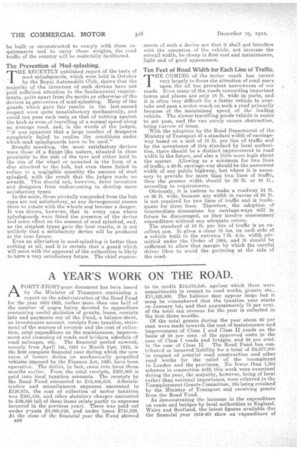A YEAR'S WORK ON THE ROAD.
Page 2

Page 3

If you've noticed an error in this article please click here to report it so we can fix it.
AFORTY-EIGHT-page document has been issued by the Minister of Transport containing a report on the administration of the Road Fund for the year 19214922, rather more than one half of the number of pages being devoted to appendices containing useful statistics of grants, loans, receipts into and payments out of the Fund, a balance-sheet, an investments account, receipts from taxation, statement of the sources of revenue and the cost of collection, total expenditure on the maintenance, improvement and cleansing of roads and bridge, schedule of road mileages, etc. The financial period covered, namely from April 1st, 1921 to March 31.st, 1922, is the first complete financial year during which the new rates of licence duties on mechanically propelled vehicles imposed by the Finance Act, 1920, have been operative. The duties, in fact, came into force three months earlier. From the total receipts, 2601,000 is paid into local taxation accounts. The receipts by the Road Fund amounted to £12,585,633. Administrative and miscellaneous expenses amounted to 2120,878, the cost of collection of motor taxation was 2301,435: and other statutory charges amounted to 139,583 (all of these items relate partly to expenses incurred in the previous year). There was paid out under rants 28,868,156, and under loans 2741,026. At the close of the financial year the Fund showed
B16
to its credit £16,010,548, against which there were commitments in respect to road works, grants, etc., 211,223,000. The balance may appear largo but it must be remembered that the taxation year starts on January 1st,, and that approximately 75 per cent, of the total tax revenue for the year is collected in the first three months.
Of the total grants during the year about 60 per cent. were made towards the cost of Maintenance and iatprovenient of Class I and Class II roads on the basis of 50 per cent, of the approved costs in the case of Class I roads and bridges, and 25 per cent in the case of Class II. The Road Fund has contributed or incurred liability for a total of £6,077,000 in respect of arterial road construction and other road works for the relief of the unemployed in London and the provinces. No fewer than 1,504 schemes in connection with this work were examined during the year, the majority, however, being of local rather than national importance, were referred to the Unemployment Grants Committee, 164 being retained by the Ministry of TranSport and receiving grants from the Road Fund.
As demonstrating the increase in the expenditure on roads and bridges by local authorities in England, Wales and Scotland, the latest figures available (for the financial year 1919-20) show an expenditure of £25,815,267 for England and Wales and £2,598,407 for Scotland, as compared with £47,567,331 and £1,484,147 respectively for the year 1914-15.
The scheme for the classification of the roads has now been finally revised, and the appendices show that, of the grand total of 177,3091 miles of roads in England, Scotland and Wales, 22,756 fall into the category of Class I and 14,646 into the category of Class If, their respective percentages of the total being 12.8 and 8.3.
Wtih regard to the asSigning of identification numbers to the roads, the entire scheme should be completed before the end-of the year, and arrangements have been made for the publication of official maps by the Ordnance Survey Department showing Class I and Class II roads in distinctive colours, together with the route numbers which have been assigned to them. A great deal of care has been taken in selecting the roads forming continuous routes for the purpose of assigning identification numbers. A number of schemes has been under consideration for improving, strengthening Or reconstructing highway bridges, and a standardized load has been laid down which, so far as possible, all bridges required to carry normal traffic will be expected to bear. In industrial ndustrial districts,where heavy indivisible loads in excess of 16 tons have to be dealt with, the bridges must be designed of greater strength accord-. ingly. The load specified is one traction engine and three trailers, the actual load allowable to be : Engine 20 tons and each trailer 13 tons, plus 50 per cent, in each-.case for impact.. This latter allowance can cnly be regarded as an empirical figure, for which it is hoped to substitute an appropriate formula as a result of experiments which are now proceeding. he report points to the difficulties which arise in connection with those bridges which are maintainable by railway companies, canal companies and such like.
The report deals with such matters as the Lights on Vehicles Bill, which was drafted in the department, damage to fisheries by washings from tartreated roads, the work of the Advisory Committee an London Traffic, and with the wonderful work which is being done on the arterial roads in the area of Greater Landon and in the provinces.




























